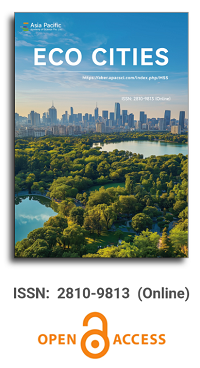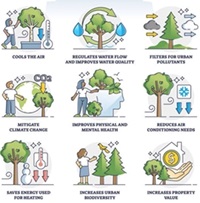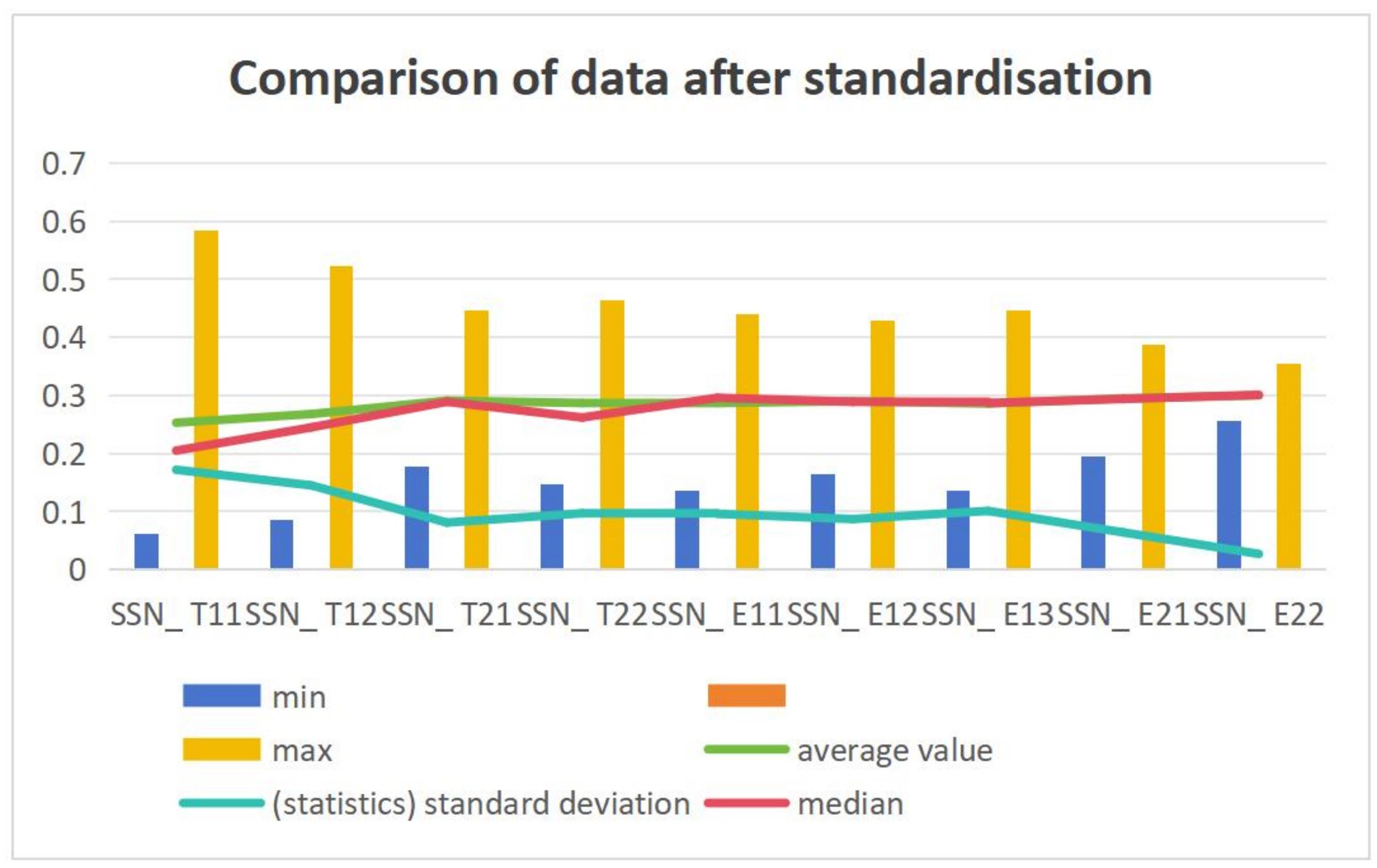


Spatio-temporal analysis of urban heat island dynamics in urban centers landscape of southwest Ethiopia
Vol 6, Issue 1, 2025
Download PDF
Abstract
Climate change is becoming a global threat to human well-being and the sustainability of the planet Earth. The central cores of urban centers are significantly observed warmer than their surrounding outskirts or rural areas, which is identified as the urban heat island (UHI) effect fueled by massive Land Use Land Cover (LULC) change. The main research aim was to examine the Spatio-temporal variation of UHI dynamics based on the land surface temperature (LST), Normalized Difference Vegetation Index (NDVI) and built-up density in the urban centers (Jimma, Bedelle, Bonga, and Sokorru) landscape using techniques of remote sensing. In this study, Landsat thematic mapper (TM) for 1987 and Landsat Operational Imagery (OLI) for 2018 in the extraction of LST were used for examining UHI. Also, LULC, NDVI and built-up density of the urban centers were analyzed. The results of the study showed that the urban core had greater LST and UHI values, due to an increase of built-up density and a decline of green space. The result of LST mean value range rose from 20.1 ℃ (Bonga) to 23.3 ℃ (Sokorru) in 1987 and 22.67 ℃ (Bedelle) to 24.74 ℃ (Bonga), and 24.72 ℃ (Sokorru) in 2018, while the maximum observed LST value range from 28.97 ℃ (Jimma) in 1987 to 32.61 ℃ (Bonga) in 2018. The maximum range of UHI mean value was from 11.23 ℃ (1987) to 14.04 ℃ (2018), while the maximum observed UHI value ranged from 19.63 ℃ in 1987 to 23.32 ℃ in 2018 over Jimma city. The computed correlation at 5% significance results showed LULC change has a significant association with surface air temperature (r = 0.621, Sig. (2-tailed) = 0.031) accompanied by UHI impacts. We recommended urban authorities, policymakers, and urban planners should consider the effects of LST and UHI in urban planning to realize climate-smart urban centers of tomorrow in urban centers of southwest Ethiopia.
Keywords
References
- Kassahun S, Tiwari A. Urban development in Ethiopia: challenges and policy responses. Available online: https://ssrn.com/abstract=2154776 (accessed on 10 September 2024).
- Yu Z, Yao Y, Yang G, et al. Strong contribution of rapid urbanization and urban agglomeration development to regional thermal environment dynamics and evolution. Forest Ecology and Management. 2019; 446: 214-225. doi: 10.1016/j.foreco.2019.05.046
- Ministry of Finance and Economic Development (MoFED). Ethiopia: Building on Progress: A Plan for Accelerated and Sustained Development to End Poverty (PASDEP). Ministry of Finance and Economic Development (MoFED), Addis Ababa. 2006. Available online: https://www.afdb.org/fileadmin/uploads/afdb/Documents/Policy- Documents/Plan_for_Accelerated_and_Sustained_%28PASDEP%29_final_July_2007_Volume_I_3.pdf (accessed on 10 September 2024).
- Kim SW, Brown RD. Urban heat island (UHI) intensity and magnitude estimations: A systematic literature review. Science of The Total Environment. 2021; 779: 146389. doi: 10.1016/j.scitotenv.2021.146389
- Doan VQ, Kusaka H, Nguyen TM. Roles of past, present, and future land use and anthropogenic heat release changes on urban heat island effects in Hanoi, Vietnam: Numerical experiments with a regional climate model. Sustainable Cities and Society. 2019; 47: 101479. doi: 10.1016/j.scs.2019.101479
- Nwakaire CM, Onn CC, Yap SP, et al. Urban heat island studies with emphasis on urban pavements: a review. Sustain Cities Society. 2020; 63:102476. doi: 10.1016/j.scs.2020.102476
- Wang L, Hou H, Weng J. Ordinary least squares modelling of urban heat island intensity based on landscape composition and configuration: A comparative study among three megacities along the Yangtze River. Sustainable Cities and Society. 2020; 62: 102381. doi: 10.1016/j.scs.2020.102381
- Matloob A, Sarif MdO, Um JS. Evaluating the inter-relationship between OCO-2 XCO2 and MODIS-LST in an Industrial Belt located at Western Bengaluru City of India. Spatial Information Research. 2021; 29(3): 257-265. doi: 10.1007/s41324-021-00396-4
- Sadiq Khan M, Ullah S, Sun T, et al. Land-Use/Land-Cover Changes and Its Contribution to Urban Heat Island: A Case Study of Islamabad, Pakistan. Sustainability. 2020; 12(9): 3861. doi: 10.3390/su12093861
- Coutts AM, Beringer J, Tapper NJ. Impact of Increasing Urban Density on Local Climate: Spatial and Temporal Variations in the Surface Energy Balance in Melbourne, Australia. Journal of Applied Meteorology and Climatology. 2007; 46(4): 477-493. doi: 10.1175/jam2462.1
- Voogt JA. Urban Heat Island. In: Munn T (editor). Encyclopedia of Global Environmental Change. Wiley, Chichester; 2002. pp. 660-666.
- Oke TR, Mills G, Christen A, et al. Urban climates. Cambridge: Cambridge University Press; 2017.
- Oke TR. Canyon geometry and the nocturnal urban heat island: Comparison of scale model and field observations. Journal of Climatology. 1981; 1(3): 237-254. doi: 10.1002/joc.3370010304
- World Meteorological Organization (WMO). WMO Guidance on the Canopy Layer Urban Heat Island. 2021. doi: 10.5194/ems2021-301, 2021
- Zhou Z, Xie Q. Impact of Urbanization on Urban Heat Island and Effect Based on TM Imagery in Wuhan China. Environmental Engineering and Management Journal. 2015; 14(3): 647-655. doi: 10.30638/eemj.2015.072
- Dessu T, Korecha D, Hunde D, et al. Long-Term Land Use Land Cover Change in Urban Centers of Southwest Ethiopia From a Climate Change Perspective. Frontiers in Climate. 2020; 2. doi: 10.3389/fclim.2020.577169
- Yuvaraj RM. Extents of predictors for land surface temperature using multiple regression model. Scientific World Journal. 2020. doi: 10.1155/2020/3958589
- Zhang B, Xie G di, Gao J xi, et al. The cooling effect of urban green spaces as a contribution to energy-saving and emission-reduction: A case study in Beijing, China. Building and Environment. 2014; 76: 37-43. doi: 10.1016/j.buildenv.2014.03.003
- He BJ. Towards the next generation of green building for urban heat island mitigation: Zero UHI impact building. Sustainable Cities and Society. 2019; 50: 101647. doi: 10.1016/j.scs.2019.101647
- Qiao Z, Liu L, Qin Y, et al. The Impact of Urban Renewal on Land Surface Temperature Changes: A Case Study in the Main City of Guangzhou, China. Remote Sensing. 2020; 12(5): 794. doi: 10.3390/rs12050794
- Intergovernmental Panel on Climate Change (IPCC). Climate Change 2022—Impacts, Adaptation and Vulnerability: Working Group II Contribution to the Sixth Assessment Report of the Intergovernmental Panel on Climate Change. Cambridge University Press; 2023.
- Amani-Beni M, Zhang B, Xie GD, et al. Impacts of Urban Green Landscape Patterns on Land Surface Temperature: Evidence from the Adjacent Area of Olympic Forest Park of Beijing, China. Sustainability. 2019; 11(2): 513. doi: 10.3390/su11020513
- Portela CI, Massi KG, Rodrigues T, et al. Impact of urban and industrial features on land surface temperature: Evidences from satellite thermal indices. Sustainable Cities and Society. 2020; 56: 102100. doi: 10.1016/j.scs.2020.102100
- Grimmond S, Bouchet V, Molina LT, et al. Integrated urban hydrometeorological, climate and environmental services: Concept, methodology and key messages. Urban Climate. 2020; 33: 100623. doi: 10.1016/j.uclim.2020.100623
- Wang H, Zhang Y, Tsou J, et al. Surface Urban Heat Island Analysis of Shanghai (China) Based on the Change of Land Use and Land Cover. Sustainability. 2017; 9(9): 1538. doi: 10.3390/su9091538
- Alfraihat R, Mulugeta G, Gala TS. Ecological evaluation of urban heat island in Chicago city, USA. Journal of Atmospheric Pollution. 2016; 4(1): 23–29. doi: 10.12691/jap-4-1-3
- Kafy AA, Abdullah-Al-Faisal, Rahman MdS, et al. Prediction of seasonal urban thermal field variance index using machine learning algorithms in Cumilla, Bangladesh. Sustainable Cities and Society. 2021; 64: 102542. doi: 10.1016/j.scs.2020.102542
- Nuruzzaman Md. Urban Heat Island: Causes, Effects and Mitigation Measures—A Review. International Journal of Environmental Monitoring and Analysis. 2015; 3(2): 67. doi: 10.11648/j.ijema.20150302.15
- Li X, Stringer LC, Dallimer M. The Spatial and Temporal Characteristics of Urban Heat Island Intensity: Implications for East Africa’s Urban Development. Climate. 2021; 9(4): 51. doi: 10.3390/cli9040051
- Chaka DS, Oda TK. Understanding land surface temperature on rift areas to examine the spatial variation of urban heat island: the case of Hawassa, southern Ethiopia. GeoJournal. 2019; 86(2): 993-1014. doi: 10.1007/s10708-019-10110-5
- Moisa MB, Merga BB, Gemeda DO. Urban heat island dynamics in response to land use land cover change: a case of Jimma city, southwestern Ethiopia. Theoretical and Applied Climatology. 2022; 149(1-2): 413-423. doi: 10.1007/s00704-022-04055-y
- Degefu MA, Argaw M, Feyisa GL, et al. Dynamics of green spaces- Land surface temperature intensity nexus in cities of Ethiopia. Heliyon. 2023; 9(2): e13274. doi: 10.1016/j.heliyon.2023.e13274
- Tesfamariam S, Govindu V, Uncha A. Spatio-temporal analysis of urban heat island (UHI) and its effect on urban ecology: The case of Mekelle city, Northern Ethiopia. Heliyon. 2023; 9(2): e13098. doi: 10.1016/j.heliyon.2023.e13098
- Jimma City Administration. Spatial Planning and Socioeconomic Assessment of the Master Plan Under the Revision Document. Jimma City Administration. 2019.
- Ethiopian Meteorological Institute. Delivering world-class weather and climate services to Ethiopia. Available online: http://www.ethiomet.gov.et (accessed on 1 September 2024).
- Central Statistical Agency (CSA). Population Statistical Abstract. Addis Ababa: Federal Democratic Republic of Ethiopia, Population Census Commission. 2007. Available online: http://www.statsethiopia.gov.et/wp-content/uploads/2019/06/Population-and-Housing-Census-2007-National_Statistical.pdf (accessed on 10 September 2024).
- Central Statistical Agency (CSA). Population Projections for Ethiopia, Addis Ababa. Addis Ababa: Population Census Commission; 2017. pp. 2007-2037.
- Kebede G, Bewket W. Variations in rainfall and extreme event indices in the wettest part of Ethiopia. SINET: Ethiopian Journal of Science. 2009; 32(2). doi: 10.4314/sinet.v32i2.68864
- Korecha D, Sorteberg A. Construction of Homogeneous Rainfall Regimes for Ethiopia. International Journal of Climatology. 2013. Available online: https://malaria.w.uib.no/files/2014/06/DiribaPhD.pdf (accessed on 20 September 2024).
- Qin Q, Zhang N, Nan P, et al. Geothermal area detection using Landsat ETM+ thermal infrared data and its mechanistic analysis—A case study in Tengchong, China. International Journal of Applied Earth Observation and Geoinformation. 2011; 13(4): 552-559. doi: 10.1016/j.jag.2011.02.005
- Jiménez‐Muñoz JC, Sobrino JA. A generalized single‐channel method for retrieving land surface temperature from remote sensing data. Journal of Geophysical Research: Atmospheres. 2003; 108(D22). doi: 10.1029/2003jd003480
- Lo CP, Quattrochi DA. Land-Use and Land-Cover Change, Urban Heat Island Phenomenon, and Health Implications. Photogrammetric Engineering & Remote Sensing. 2003; 69(9): 1053-1063. doi: 10.14358/pers.69.9.1053
- Cheng X, Wei B, Chen G, et al. Influence of park size and its surrounding urban landscape patterns on the park cooling effect. Journal of Urban Planning and Development. 2015; 141(3): 4014002. doi: 10.1061/(ASCE)UP.1943-5444.0000256
- Landsat Project Science Office. Landsat science data user’s handbook. Available online: https://www.usgs.gov/landsat-missions/landsat-data-user-handbooks (accessed on 1 September 2024).
- Wang L, Hou H, Weng J. Ordinary least squares modelling of urban heat island intensity based on landscape composition and configuration: A comparative study among three megacities along the Yangtze River. Sustainable Cities and Society. 2020; 62: 102381. doi: 10.1016/j.scs.2020.102381
- Ramachandran J, Lalitha R, Sivasubramanian K. Remote Sensing Based Land Surface Temperature Analysis in Diverse Environment of Lalgudi Block. International Journal of Environment and Climate Change. 2019: 142-149. doi: 10.9734/ijecc/2019/v9i330103
- Balew A, Korme T. Monitoring land surface temperature in Bahir Dar city and its surrounding using Landsat images. The Egyptian Journal of Remote Sensing and Space Science. 2020; 23(3): 371-386. doi: 10.1016/j.ejrs.2020.02.001
- Guha S, Govil H, Gill N, et al. A long-term seasonal analysis on the relationship between LST and NDBI using Landsat data. Quaternary International. 2021; 575-576: 249-258. doi: 10.1016/j.quaint.2020.06.041
- Naeem S, Cao C, Qazi W, et al. Studying the Association between Green Space Characteristics and Land Surface Temperature for Sustainable Urban Environments: An Analysis of Beijing and Islamabad. ISPRS International Journal of Geo-Information. 2018; 7(2): 38. doi: 10.3390/ijgi7020038
- Kumari B, Tayyab M, Shahfahad, et al. Satellite-Driven Land Surface Temperature (LST) Using Landsat 5, 7 (TM/ETM+ SLC) and Landsat 8 (OLI/TIRS) Data and Its Association with Built-Up and Green Cover Over Urban Delhi, India. Remote Sensing in Earth Systems Sciences. 2018; 1(3-4): 63-78. doi: 10.1007/s41976-018-0004-2
- Chander G, Markham B. Revised landsat-5 tm radiometric calibration procedures and postcalibration dynamic ranges. IEEE Transactions on Geoscience and Remote Sensing. 2003; 41(11): 2674-2677. doi: 10.1109/tgrs.2003.818464
- Sobrino JA, Jiménez-Muñoz JC, Paolini L. Land surface temperature retrieval from LANDSAT TM 5. Remote Sensing of Environment. 2004; 90(4): 434-440. doi: 10.1016/j.rse.2004.02.003
- Effat H, Taha L, Mansour K. Change Detection of Land cover and Urban Heat Islands using Multi-Temporal Landsat Images, application in Tanta City, Egypt. Open Journal of Remote Sensing and Positioning. 2014; 1(2): 1-15. doi: 10.15764/rsp.2014.02001
- Maheng D, Ducton I, Lauwaet D, et al. The Sensitivity of Urban Heat Island to Urban Green Space—A Model-Based Study of City of Colombo, Sri Lanka. Atmosphere. 2019; 10(3): 151. doi: 10.3390/atmos10030151
- Abutaleb K, Ngie A, Darwish A, et al. Assessment of Urban Heat Island Using Remotely Sensed Imagery over Greater Cairo, Egypt. Advances in Remote Sensing. 2015; 04(01): 35-47. doi: 10.4236/ars.2015.41004
- Pervaiz S, Shirazi AS, Khan FZ. Tree census of urban green space with special reference to Gora Cemetery of Lahore, Pakistan. International Journal of Biosciences (IJB). 2018; 13(01): 431-439. doi: 10.12692/ijb/13.1.431-439
- Gandhi GM, Parthiban S, Thummalu N, et al. Ndvi: Vegetation Change Detection Using Remote Sensing and Gis—A Case Study of Vellore District. Procedia Computer Science. 2015; 57: 1199-1210. doi: 10.1016/j.procs.2015.07.415
- Avdan U, Jovanovska G. Algorithm for Automated Mapping of Land Surface Temperature Using LANDSAT 8 Satellite Data. Journal of Sensors. 2016; 2016: 1-8. doi: 10.1155/2016/1480307
- Moisa MB, Dejene IN, Merga BB, et al. Impacts of land use/land cover dynamics on land surface temperature using geospatial techniques in Anger River Sub-basin, Western Ethiopia. Environmental Earth Sciences. 2022; 81(3). doi: 10.1007/s12665-022-10221-2
- Stemn E, Kumi-Boateng B. Modelling of land surface temperature changes as determinant of urban heat island and risk of heat-related conditions in the Wassa West Mining Area of Ghana. Modeling Earth Systems and Environment. 2020; 6(3): 1727-1740. doi: 10.1007/s40808-020-00786-x
- Mallick J, Kant Y, Bharath BD. Estimation of land surface temperature over Delhi using Landsat-7 ETM+. The Journal of Indian Geophysical Union. 2008; 12(3): 131–140.
- Huong NTL, Yao S, Fahad S. Assessing household livelihood vulnerability to climate change: The case of Northwest Vietnam. Human and Ecological Risk Assessment: An International Journal. 2018; 25(5): 1157-1175. doi: 10.1080/10807039.2018.1460801
- Zare M, Drastig K, Zude-Sasse M. Tree Water Status in Apple Orchards Measured by Means of Land Surface Temperature and Vegetation Index (LST–NDVI) Trapezoidal Space Derived from Landsat 8 Satellite Images. Sustainability. 2019; 12(1): 70. doi: 10.3390/su12010070
- Merga BB, Moisa MB, Negash DA, et al. Land surface temperature variation in response to landuse and land-cover dynamics: a case of Didessa River sub-basin in western Ethiopia. Earth System Science. 2022; 6: 803-815. doi: 10. 1007/s41748-022-00303-3
- Moisa MB, Merga BB, Gemeda DO. Multiple indices-based assessment of agricultural drought: A case study in Gilgel Gibe Sub-basin, Southern Ethiopia. Theoretical and Applied Climatology. 2022; 148(1-2): 455-464. doi: 10.1007/s00704-022-03962-4
- Wolteji BN, Bedhadha ST, Gebre SL, et al. Multiple Indices Based Agricultural Drought Assessment in the Rift Valley Region of Ethiopia. Environmental Challenges. 2022; 7: 100488. doi: 10.1016/j.envc.2022.100488
- Alexander C. Normalised difference spectral indices and urban land cover as indicators of land surface temperature (LST). International Journal of Applied Earth Observation and Geoinformation. 2020; 86: 102013. doi: 10.1016/j.jag.2019.102013
- Sarif MdO, Gupta RD. Modelling of trajectories in urban sprawl types and their dynamics (1988-2018): a case study of Prayagraj City (India). Arabian Journal of Geosciences. 2021; 14(14). doi: 10.1007/s12517-021-07573-7
- Xu X, Qiu W, Li W, et al. Comparing satellite image and GIS data classified local climate zones to assess urban heat island: A case study of Guangzhou. Frontiers in Environmental Science. 2022; 10. doi: 10.3389/fenvs.2022.1029445
- Xu C, Huang G, Zhang M. Comparative Analysis of the Seasonal Driving Factors of the Urban Heat Environment Using Machine Learning: Evidence from the Wuhan Urban Agglomeration, China, 2020. Atmosphere. 2024; 15(6): 671. doi: 10.3390/atmos15060671
- Hu C, Zhang M, Huang G, et al. Tracking the Impact of the Land Cover Change on the Spatial-Temporal Distribution of the Thermal Comfort: Insights from the Qinhuai River Basin, China. Sustainable Cities and Society. 2024; 116. doi.org/10.1016/j.scs.2024.105916
- Zhang M, Yiğit İ, Adigüzel F, et al. Impact of Urban Surfaces on Microclimatic Conditions and Thermal Comfort in Burdur, Türkiye. Atmosphere. 2024; 15(11): 1375. doi: 10.3390/atmos15111375
Supporting Agencies
Copyright (c) 2025 Author(s)
License URL: https://creativecommons.org/licenses/by/4.0/

This site is licensed under a Creative Commons Attribution 4.0 International License (CC BY 4.0).

Chinese Academy of Sciences, China
Indexing & Archiving
Asia Pacific Academy of Science Pte. Ltd. (APACSCI) specializes in international journal publishing. APACSCI adopts the open access publishing model and provides an important communication bridge for academic groups whose interest fields include engineering, technology, medicine, computer, mathematics, agriculture and forestry, and environment.



.jpg)

.jpg)



